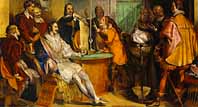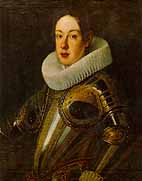Grand Duke of Tuscany
Florence 1610-1670
The son of Cosimo II and Maria Maddelena
of Austria, his father died when he was only ten years old and he spent
the next seven years under the guardianship of his mother and his grandmother,
Cristina of Lorraine. In that period Tuscany was extremly poverty-stricken
and full of religious zealots; the Grand Duchess Regents further dissipated
the slender resources of the country in aid of the armies of France and
Spain (the Thirty Years¹ War was about to break out), and in pensions
to "converts".
Of limited intelligence but kind hearted and cultured, Ferdinando tried to improve
the fortunes of the Grand Duchy by bringing his numerous brothers in to form
part of his government (brave Mattias, Cardinal Giovan Carlo and Prince Leopoldo,
who was a real genius and the family patron of the arts: he is the man who was
responsible for collecting most of the paintings and drawings that are contained
in the Galleries of the Pitti Palace and the Uffizi in
Florence today) and by launching numerous initiatives and research in the agronomic
field. However, in spite of all his efforts, he was never able to save the country
from the continuous repetition of plague and famine (in some years there were
as many as 9.000 victims in Florence alone, without counting the depopulation
in the surrounding countryside).

Academy of Cimento
He was no luckier in his policies. Having lost the Duchy of Urbino, which
was his by right as husband of the last heir of the Della Rovere family,
Vittoria, whom he married in 1634, he also failed in his attempt to create
a League among the Italian States (1635) to try and prevent the alternate
predominance of the Spanish and the French. Ferdinando did not have the
character of his great-grandfather, Cosimo I, and he knew it only too well. For this reason
he preferred to enlarge his dominion by paying for it in cash: in 1634 he
paid out the enormous sum of 50.000 scudi to buy the city of Pontremoli
from Spain and also bought the county of Santa Fiora from Count Mario Sforza.
His greatest interest was science which was eventually to gratify him most of
all. A student of Galileo Galilei and later of his followers, Torricelli and
Viviani, he founded the "Medici Experimental Academy"
(1642) and then patronized the Cimento Academy. which was created
by his brother Leopoldo (1657) and was the first proper experimental
scientifieated by his brother Leopoldo (1657) and was the first proper
experimental scientific society in Europe (its motto was "Try
and try again"). In this field he personally completed the inventions
of the thermometer and the thermoscope, he encouraged chemistry at
the Botanical gardens in Pisa, while also trying to find practical
applications for the latest technical knowledge in agriculture (he
was a real enthusiast in botanics and meteorology).
His political weakness prevented him from saving Galileo from the Holy Office,
but he did everything he could to defend him during the tower of its Cathedral
(1213) standing out in their midst.
among the Florentine hills, where he died on January 8th 1642.

